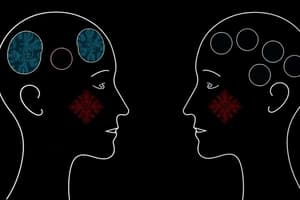Podcast
Questions and Answers
According to the content, which of the personality theories uses factor analysis as a basis for determining traits?
According to the content, which of the personality theories uses factor analysis as a basis for determining traits?
- Cattell's 16 Personality Factors (correct)
- Eysenck's Three-Factor Theory (correct)
- Allport's Trait Theory
- The Big Five Model (correct)
Which of the following is NOT one of the Big Five personality traits?
Which of the following is NOT one of the Big Five personality traits?
- Conscientiousness
- Psychoticism (correct)
- Agreeableness
- Openness
What is the primary focus of Albert Bandura's Social Cognitive Theory?
What is the primary focus of Albert Bandura's Social Cognitive Theory?
- The influence of unconscious drives on behavior
- The role of cognitive processes in behavior change (correct)
- The importance of biological factors in personality
- How the environment controls behavior
Which of the following is an example of observational learning?
Which of the following is an example of observational learning?
What is the main idea behind the Bobo Doll Experiment?
What is the main idea behind the Bobo Doll Experiment?
What is the significance of mirror neurons in relation to observational learning?
What is the significance of mirror neurons in relation to observational learning?
Which of the following theories emphasizes the role of personality traits as a primary determinant of behavior?
Which of the following theories emphasizes the role of personality traits as a primary determinant of behavior?
According to the content, which of the following factors can influence behavior, in addition to personal traits?
According to the content, which of the following factors can influence behavior, in addition to personal traits?
Which brain area is involved in regulating stress hormones like cortisol?
Which brain area is involved in regulating stress hormones like cortisol?
What is the name of the pathway that is thought to be involved in the cognitive symptoms of schizophrenia?
What is the name of the pathway that is thought to be involved in the cognitive symptoms of schizophrenia?
Which neurotransmitter is primarily associated with the raphe nuclei?
Which neurotransmitter is primarily associated with the raphe nuclei?
Which of the following is NOT a potential factor contributing to the development of depression?
Which of the following is NOT a potential factor contributing to the development of depression?
Which neurotransmitter is primarily released by the VTA?
Which neurotransmitter is primarily released by the VTA?
Which of the following brain areas is NOT directly involved in the pathways related to depression?
Which of the following brain areas is NOT directly involved in the pathways related to depression?
What is the effect of monoamine oxidase inhibitors (MAOIs) on the brain?
What is the effect of monoamine oxidase inhibitors (MAOIs) on the brain?
Which of the following is a possible explanation for the development of Alzheimer's disease, according to the content?
Which of the following is a possible explanation for the development of Alzheimer's disease, according to the content?
What is a key indicator that a person does not have a psychological disorder?
What is a key indicator that a person does not have a psychological disorder?
Which of the following is included in Neurodevelopmental Disorders?
Which of the following is included in Neurodevelopmental Disorders?
What distinguishes Neurocognitive Disorders from other categories?
What distinguishes Neurocognitive Disorders from other categories?
What is a common characteristic of Anxiety Disorders?
What is a common characteristic of Anxiety Disorders?
Which disorder is associated with episodes of abnormally positive mood?
Which disorder is associated with episodes of abnormally positive mood?
What does Trauma/Stressor-Related Disorders encompass?
What does Trauma/Stressor-Related Disorders encompass?
Substance-Related and Addictive Disorders are defined by which of the following?
Substance-Related and Addictive Disorders are defined by which of the following?
Which of the following statements is true regarding Personality Disorders?
Which of the following statements is true regarding Personality Disorders?
Which cluster of personality disorders is characterized by odd or eccentric behavior?
Which cluster of personality disorders is characterized by odd or eccentric behavior?
What type of disorder involves distress due to symptoms resembling physical illness but with a psychological origin?
What type of disorder involves distress due to symptoms resembling physical illness but with a psychological origin?
Which disorder is characterized by compulsive behaviors driven by unwelcome thoughts?
Which disorder is characterized by compulsive behaviors driven by unwelcome thoughts?
What best describes the symptoms of schizophrenia related to cognitive abilities?
What best describes the symptoms of schizophrenia related to cognitive abilities?
Which type of disorder involves significant abnormalities in sexual performance?
Which type of disorder involves significant abnormalities in sexual performance?
In the context of schizophrenia, what does an increase in dopamine typically correlate with?
In the context of schizophrenia, what does an increase in dopamine typically correlate with?
What defines paraphilic disorders?
What defines paraphilic disorders?
Which statement accurately describes Dissociative Disorders?
Which statement accurately describes Dissociative Disorders?
What is the main difference between behaviourist and psychoanalytic theories of personality?
What is the main difference between behaviourist and psychoanalytic theories of personality?
What is the primary concept that distinguishes Skinner's behaviourist theory from Pavlov's?
What is the primary concept that distinguishes Skinner's behaviourist theory from Pavlov's?
What is the core idea behind the concept of "operant conditioning"?
What is the core idea behind the concept of "operant conditioning"?
Which of the following is NOT a key feature of the behaviourist theory?
Which of the following is NOT a key feature of the behaviourist theory?
What is the main difference between source traits and surface traits?
What is the main difference between source traits and surface traits?
Which of the following is NOT considered a category of traits according to Gordon Allport?
Which of the following is NOT considered a category of traits according to Gordon Allport?
Which theory serves as a bridge between traditional behaviourism and other perspectives, such as the psychoanalytic theory?
Which theory serves as a bridge between traditional behaviourism and other perspectives, such as the psychoanalytic theory?
According to the trait theory, what is the primary factor that shapes a person's personality?
According to the trait theory, what is the primary factor that shapes a person's personality?
What did the researchers discover about the children who were initially exposed to the aggressive behavior towards the Bobo doll?
What did the researchers discover about the children who were initially exposed to the aggressive behavior towards the Bobo doll?
In the study, what was the purpose of offering stickers and juice to the children?
In the study, what was the purpose of offering stickers and juice to the children?
Which of the following is NOT a factor involved in learning a new behavior according to the "Attention, Memory, Imitation, Motivation" model?
Which of the following is NOT a factor involved in learning a new behavior according to the "Attention, Memory, Imitation, Motivation" model?
Which of the following statements accurately reflects the connection between mental disorders and brain function?
Which of the following statements accurately reflects the connection between mental disorders and brain function?
What is the key difference between the biopsychosocial model and the biomedical model of mental disorders?
What is the key difference between the biopsychosocial model and the biomedical model of mental disorders?
What is the primary function of the DSM-5?
What is the primary function of the DSM-5?
What percentage of the US population will meet the criteria for at least one mental disorder in a given year?
What percentage of the US population will meet the criteria for at least one mental disorder in a given year?
What does the text imply about the categorization of mental disorders?
What does the text imply about the categorization of mental disorders?
Flashcards
Behaviourist Theory
Behaviourist Theory
A theory of personality that suggests personality is the result of learned behavior patterns based on a person's environment. It emphasizes the role of environmental factors in shaping behavior.
Operant Conditioning
Operant Conditioning
This concept, proposed by B.F. Skinner, suggests that behaviors are learned through consequences. Behaviors followed by rewards are more likely to be repeated, while those followed by punishment are less likely to be repeated.
Cognitive Theory
Cognitive Theory
A theory that emphasizes the role of mental processes in shaping behavior and personality. It suggests that people's thoughts, feelings, and beliefs influence how they interact with the world. It can be understood as a bridge between classic behaviorism and other theories like psychoanalytic theory.
Trait
Trait
Signup and view all the flashcards
Surface Traits
Surface Traits
Signup and view all the flashcards
Source Traits
Source Traits
Signup and view all the flashcards
Cardinal Trait
Cardinal Trait
Signup and view all the flashcards
Central Trait
Central Trait
Signup and view all the flashcards
Factor analysis
Factor analysis
Signup and view all the flashcards
Observational Learning
Observational Learning
Signup and view all the flashcards
Big Five Model (OCEAN)
Big Five Model (OCEAN)
Signup and view all the flashcards
Neuroticism
Neuroticism
Signup and view all the flashcards
Openness to Experience
Openness to Experience
Signup and view all the flashcards
Conscientiousness
Conscientiousness
Signup and view all the flashcards
Bobo Doll Experiment
Bobo Doll Experiment
Signup and view all the flashcards
Social Cognitive Theory
Social Cognitive Theory
Signup and view all the flashcards
Learning-Performance Distinction
Learning-Performance Distinction
Signup and view all the flashcards
Biopsychosocial Model
Biopsychosocial Model
Signup and view all the flashcards
ICD-10
ICD-10
Signup and view all the flashcards
DSM-5
DSM-5
Signup and view all the flashcards
Social Learning Theory (Bandura)
Social Learning Theory (Bandura)
Signup and view all the flashcards
Motivation (in Learning)
Motivation (in Learning)
Signup and view all the flashcards
Memory (in Learning)
Memory (in Learning)
Signup and view all the flashcards
Distress/Disability Criterion
Distress/Disability Criterion
Signup and view all the flashcards
What is a psychological disorder?
What is a psychological disorder?
Signup and view all the flashcards
What is the DSM-5?
What is the DSM-5?
Signup and view all the flashcards
Neurodevelopmental Disorders
Neurodevelopmental Disorders
Signup and view all the flashcards
Neurocognitive Disorders
Neurocognitive Disorders
Signup and view all the flashcards
Trauma/Stressor-Related Disorders
Trauma/Stressor-Related Disorders
Signup and view all the flashcards
Substance-Related and Addictive Disorders
Substance-Related and Addictive Disorders
Signup and view all the flashcards
Personality Disorders
Personality Disorders
Signup and view all the flashcards
Cluster A Personality Disorders
Cluster A Personality Disorders
Signup and view all the flashcards
Cluster B Personality Disorders
Cluster B Personality Disorders
Signup and view all the flashcards
Cluster C Personality Disorders
Cluster C Personality Disorders
Signup and view all the flashcards
Disruptive, Impulse-Control and Conduct Disorders
Disruptive, Impulse-Control and Conduct Disorders
Signup and view all the flashcards
Obsessive-Compulsive and Related Disorders
Obsessive-Compulsive and Related Disorders
Signup and view all the flashcards
Somatic Symptom and Related Disorders
Somatic Symptom and Related Disorders
Signup and view all the flashcards
Psychotic Disorders
Psychotic Disorders
Signup and view all the flashcards
Schizophrenia
Schizophrenia
Signup and view all the flashcards
Mesocorticolimbic Pathway
Mesocorticolimbic Pathway
Signup and view all the flashcards
Mesocorticolimbic Pathway Dysfunction
Mesocorticolimbic Pathway Dysfunction
Signup and view all the flashcards
Limbic Structures
Limbic Structures
Signup and view all the flashcards
Negative Symptoms of Schizophrenia
Negative Symptoms of Schizophrenia
Signup and view all the flashcards
Temporal Cortex and Positive Symptoms
Temporal Cortex and Positive Symptoms
Signup and view all the flashcards
Depression
Depression
Signup and view all the flashcards
Hypothalamus
Hypothalamus
Signup and view all the flashcards
Neurotransmitter Imbalance Theory
Neurotransmitter Imbalance Theory
Signup and view all the flashcards
Study Notes
Behaviourist Theory
- Personality is the result of learned behaviour patterns determined by the environment.
- Individuals start as blank slates, shaped entirely by environmental influences.
- Focuses on observable, measurable behaviours, rather than mental processes.
- Psychoanalytic theory is the opposite, focusing on mental behaviour.
Skinner
- Developed operant conditioning.
- Uses rewards and punishments to increase or decrease behaviours.
Pavlov
- Developed classical conditioning.
- Neutral stimulus paired with an unconditioned stimulus to trigger an involuntary response.
- Example: ringing a bell with food to make a dog salivate.
Trait Theory
-
Personality traits are stable predispositions towards particular behaviours.
-
Straightforward way to describe personality.
-
Surface traits are observable behaviours; source traits are underlying, more abstract factors.
-
Traits are relatively stable characteristics causing consistent behaviour patterns.
Gordon Allport
- Believes everyone has different traits.
- Identified 3 categories of traits:
- Cardinal traits: dominate a person's life.
- Central traits: frequently seen in a person's behaviour.
- Secondary traits: less frequent and less influential than central traits.
Other Trait Theorists
- Raymond Cattell: proposed 16 personality factors (16PF).
- Hans Eysenck: identified 3 dimensions of personality (extroversion, neuroticism, psychoticism).
- Big 5 (Five-Factor Model): a widely used framework identifying 5 major categories of personality traits: Openness, Conscientiousness, Extraversion, Agreeableness, Neuroticism (OCEAN).
Observational Learning (Social Cognitive)
- Learning by observing and imitating others.
- Bobo Doll experiment demonstrated this type of learning and the importance of environmental factors, social influences & cognitive processes.
- Mirror neurons support this theory, through observation of actions from others.
Psychological Disorders
- Includes numerous types with overlapping features.
- Not due to external factors like medication or drugs.
- Often causes distress or disability.
- DSM-5 and ICD-10 are classification systems.
Types of Mental Disorders (20 major categories in DSM-5)
-
Neurodevelopmental disorders: abnormalities in development (intellectual disability, autism, ADHD).
-
Neurocognitive disorders: losses in cognitive function (delirium, dementia).
-
Sleep-wake disorders: problems with sleep (insomnia, sleep apnea).
-
Anxiety disorders: excessive worry and fear (generalized anxiety, panic disorder, phobias).
-
Depressive disorders: persistent negative mood (major depressive, persistent depressive).
-
Bipolar disorder: alternating between periods of depression and mania.
-
Schizophrenia spectrum and other psychotic disorders: severe disturbances in thinking and perception (hallucinations, delusions).
-
Trauma/stressor-related disorders: reactions to stressful events (PTSD).
-
Personality disorders: enduring patterns of behaviour causing distress or impairment.
Biological Bases
- Various biological factors play a role in both mental health and disorders (genes, brain abnormalities, etc).
Alzheimer's Disease
- Characterised by memory loss, brain tissue atrophy, and 3 main abnormalities under microscope: plaques, tangles & loss of neurons.
- Genetic factors and high blood pressure may increase risk for Alzheimer's.
- Early diagnosis is important for disease management
Parkinson's Disease
- Characterized by motor abnormalities (tremors, rigidity, slow movement) and reduced dopamine levels in the brain's substantia nigra. Genes and agricultural factors can influence susceptibility to the disease.
Studying That Suits You
Use AI to generate personalized quizzes and flashcards to suit your learning preferences.




